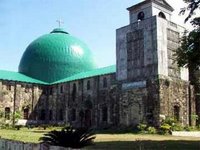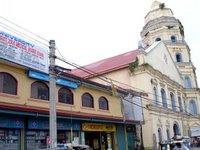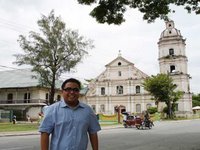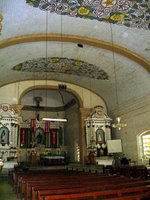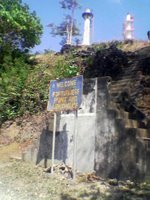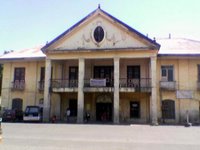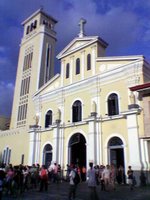 Today was the last day of our road trip. We got up just in time for the complimentary breakfast at Villa Cordillera. Eating at the hotel restaurant Le Terrace is always a great experience since the panoramic view of the pine tree-covered hill behind the hotel is very relaxing to the senses. After paying our hotel bill, we were off to La Trinidad's strawberry fields.
Today was the last day of our road trip. We got up just in time for the complimentary breakfast at Villa Cordillera. Eating at the hotel restaurant Le Terrace is always a great experience since the panoramic view of the pine tree-covered hill behind the hotel is very relaxing to the senses. After paying our hotel bill, we were off to La Trinidad's strawberry fields. Right beside the boundary arch between Baguio City and La Trinidad is the entrance of one of Baguio's hidden secrets, a Chinese temple called Bell Church. Not many people know about it since it's quite far from all the other city attractions. And today, it is easily obscured by all the urban chaos that sadly accumulated along the way to La Trinidad. We decided to stopover for a few minutes to check it out.
Right beside the boundary arch between Baguio City and La Trinidad is the entrance of one of Baguio's hidden secrets, a Chinese temple called Bell Church. Not many people know about it since it's quite far from all the other city attractions. And today, it is easily obscured by all the urban chaos that sadly accumulated along the way to La Trinidad. We decided to stopover for a few minutes to check it out. It's my second time to visit the strawberry fields in two weeks. Picking strawberries was a bit cheaper this time around at PHP150 a kilo. The price of those sold by the vendors was the same too and I got several kilos of strawberries for PHP70 each. We had lunch at Kalei's. The place and ambiance is much better that where Jolly Yan is located. And the food, just as affordable with its "meat plus meat" at PHP50. But I still think the home-cooked meals of Jolly Yan are worth the visit.
It's my second time to visit the strawberry fields in two weeks. Picking strawberries was a bit cheaper this time around at PHP150 a kilo. The price of those sold by the vendors was the same too and I got several kilos of strawberries for PHP70 each. We had lunch at Kalei's. The place and ambiance is much better that where Jolly Yan is located. And the food, just as affordable with its "meat plus meat" at PHP50. But I still think the home-cooked meals of Jolly Yan are worth the visit. After lunch, we left Doc Ryan in La Trinidad and began our trip back to Metro Manila via Kennon Road. For most people, since the trip back to Manila is relatively long and tiring, they just keep on driving as fast as they could down Kennon Road. And as a result, we rarely notice the scenery along the route. I'm sure we've all seen the waterfalls along the route. But have you ever stopped to check them out up close?
After lunch, we left Doc Ryan in La Trinidad and began our trip back to Metro Manila via Kennon Road. For most people, since the trip back to Manila is relatively long and tiring, they just keep on driving as fast as they could down Kennon Road. And as a result, we rarely notice the scenery along the route. I'm sure we've all seen the waterfalls along the route. But have you ever stopped to check them out up close?Bridal Veil Falls actually caught our fancy since there was a pedestrian suspension bridge that connected it to Kennon Road. So we parked the car in front of a store and crossed the makeshift bridge. Below us was a mountain stream that emptied into a vast riverbed further down the road. I guess the falls got its name from the fact that it resembled a bridal veil as the water cascaded down the smoothened rock into a small pool.
 I really think that the entire length of Kennon Road should be declared a protected cultural landscape because most of the scenic route - the picturesque view of the mountains, lush vegetation and pine trees - is still intact. There is a need to regulate the construction of new structures in order to protect the historical fabric of our country's oldest mountain road which was completed in 1905. I hope the National Historical Institute or the National Museum act fast before it's too late.
I really think that the entire length of Kennon Road should be declared a protected cultural landscape because most of the scenic route - the picturesque view of the mountains, lush vegetation and pine trees - is still intact. There is a need to regulate the construction of new structures in order to protect the historical fabric of our country's oldest mountain road which was completed in 1905. I hope the National Historical Institute or the National Museum act fast before it's too late. Anyway, we finally crossed the Benguet-La Union boundary and just a few kilometers away, the boundary of Pangasinan. I had to pass by Rosales for a while to talk with the mayor. I was pleasantly surprised that the restoration of the old municipal hall was finally complete. Unlike other towns such as Moncada, Tarlac which bastardized their elegant colonial-era town halls, Rosales chose to preserve theirs. In fact, even the pre-war statues of a farmer on a carabao with his wife were rehabilitated and repainted, bringing out the vivid colors that were very chic during the pre-war days.
Anyway, we finally crossed the Benguet-La Union boundary and just a few kilometers away, the boundary of Pangasinan. I had to pass by Rosales for a while to talk with the mayor. I was pleasantly surprised that the restoration of the old municipal hall was finally complete. Unlike other towns such as Moncada, Tarlac which bastardized their elegant colonial-era town halls, Rosales chose to preserve theirs. In fact, even the pre-war statues of a farmer on a carabao with his wife were rehabilitated and repainted, bringing out the vivid colors that were very chic during the pre-war days. Our last stop for the day was the Isdaan Resaurant in Gerona. This one is an attraction in itself. I congratulate the owners for such a great concept. If you've heard of the Tacsiyapo Wall (tacsiyapo is a Kapampangan expletive), you can find it here. From cups at PHP15, to clocks and working television sets, customers can purchase these items to hurl at a wall to release their anger. On the wall, several target words are painted such as 5/6, ex-wife, professors and classmates; sugal, alak and babae; boss, managers, and supervisors; and many others.
Our last stop for the day was the Isdaan Resaurant in Gerona. This one is an attraction in itself. I congratulate the owners for such a great concept. If you've heard of the Tacsiyapo Wall (tacsiyapo is a Kapampangan expletive), you can find it here. From cups at PHP15, to clocks and working television sets, customers can purchase these items to hurl at a wall to release their anger. On the wall, several target words are painted such as 5/6, ex-wife, professors and classmates; sugal, alak and babae; boss, managers, and supervisors; and many others. The food is a bit pricey though and expect to spend at least PHP200 per head. But you go here for the experience. And the food is great too. We ordered Innapoy rice rolls for our appetizer which was suman with longganiza, bakang maanghang and chicken curry in it. It's something new and I really liked it. For dinner, we had binalot rice meals. Anyway, after this dinner stopover, we continued our trip back to Manila.
The food is a bit pricey though and expect to spend at least PHP200 per head. But you go here for the experience. And the food is great too. We ordered Innapoy rice rolls for our appetizer which was suman with longganiza, bakang maanghang and chicken curry in it. It's something new and I really liked it. For dinner, we had binalot rice meals. Anyway, after this dinner stopover, we continued our trip back to Manila.I have class tomorrow and a report at that so I guess I'll just be home preparing for it.


